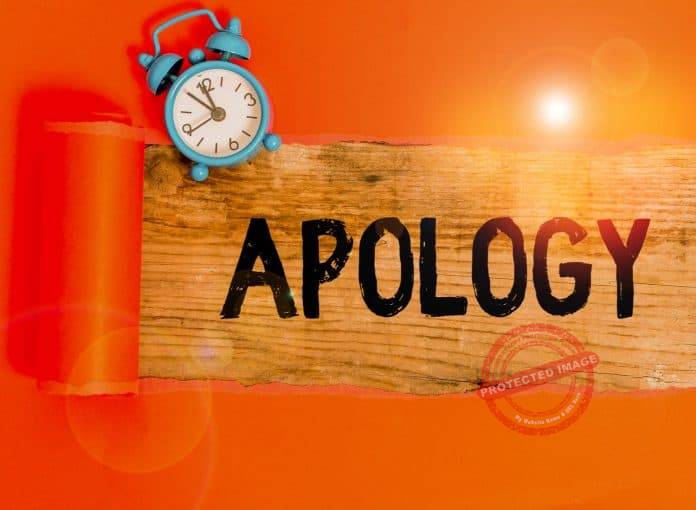Do you want to learn how to apologize without saying sorry in business? Well, for starters, it is not difficult to do.
We will show you several ways to do this.
Apologizing without uttering the word “sorry” as a business owner is very important, but why is that so?
Let’s find out together, shall we?
What Apologizing With “I am sorry” Does to Your Business – How to Apologize without Saying Sorry in Business
As a business owner, you often want to please your customers/clients to ensure they continue patronizing you.
This is proper.
However, there are instances where I am sorry is not the solution to customer – client friction.
An example is when your company is not at fault for the customer’s inconveniences.
In this kind of situation, blurting out “I am sorry” is not the solution.
This might not help the situation.
Instead, it will reduce your business’s credibility and reputation.
Your customer will question their decision to hire you if you keep apologizing with “I am sorry,”; especially if the fault is not yours.
Most times, when you admit to being at fault, your customer might see that as a way to profit from you, whether it is your fault or not.
Therefore, be smart with how you handle the problem.
Above all, saying “I am sorry” does not always solve problems.
Ways to Apologize without Saying Sorry – How to Apologize without Saying Sorry in Business
As we earlier discussed, saying “I am sorry” is not always ideal for handling issues that might arise in your business.
So, how do you solve issues without saying sorry?
Here are some alternative ways on how to apologize without saying sorry in business:
Say “Thank You” Instead
Not every situation demands you to apologize with “I’m sorry.”
You can show your concern without letting yourself down when you use “thank you” instead of “sorry.”
An instance where you can use this is when a project is behind time, you can clearly communicate the reasons for the delay as say
“Thank you as you stay patient while we work on getting the project ready by the end of this week.”
Use of Actions Instead of Words
You can apologize at home and some other places using “sorry”; this is usually an effective heartfelt reply to disappointment.
It shows humility at its highest peak and also seeks atonement.
However, it can be seen as a way of making excuses when it has been overused.
So, instead of the word sorry constantly, you can actively take steps to correct the mistake and minimize the damages.
Action works better than words; this is a very good alternative.
Be Empathetic Instead of Offering Sympathy with “Sorry.”
Instead of showing sympathy with “I am sorry,” be empathetic and reflect on what someone else is feeling.
You can do this by saying something like: “That is sad, it must have been difficult for you” when someone shares his/ her experience with you.
When you only say sorry, it shows sympathy, which oftentimes does not make that person feel better, heard, or valued.
Practice Self-Awareness – How to Apologize without Saying Sorry in Business
You ought to try out this emotional intelligence tactic.
Ask yourself this question; “Why do I need to be sorry every time”?
So, instead of apologizing with the traditional “I am sorry,” say, “I appreciate you for observing that.
What else have you noticed?”
Fix your mind on what will bring out the desired result.
Overall, practice greater self-restraint and self-awareness.
When Failure/Mistakes Happens, be Confident and Work to rectify it
When failure/mistakes happen in your business, be confident instead of fidgeting and singing the sorry word like you have hurt someone emotionally or physically.
Tell yourself and the people depending on you: “This was not how it was planned, but we got this, let’s get back to work.”
Take the bull by the horn and work towards rectifying the issue.
Your Perspective must be Practical
When opinions are not different during arguments, people tend to say things like “I do not agree with you, I am sorry” unconsciously.
That statement takes your power away.
To keep your perspective purely practical, you could say this instead “Let’s see this from a different angle.”
Be Unapologetic about Speaking Your Mind
You do not have to apologize before asking a question or having an idea to ensure your work gets done.
Instead of saying “I am sorry” before asking a question or chipping in your opinion in a discussion, speak your mind when there is an opening.
This will prove that you are sure and confident about what you are saying.
Ask for Feedback
When you apologize too much, it can result from a lack of confidence and trust in yourself and your business.
A good way to boost your self-confidence and self-belief is by receiving feedback.
Ask for feedback from your customers/client about the ways you could do things differently.
If such feedback is constructive and you work toward improvement, you would notice that your confidence and trust in yourself and your business have increased.
Right Ways to Apologize when Your Business is at Fault – How to Apologize without Saying Sorry in Business
As much as saying sorry is not the ideal thing to say as a business person, apologies still have their place in the business setting.
One of those times you need to apologize is when your business is at fault.
It will be very unethical and wrong to overlook your wrongdoings because you cannot say, “I am sorry.”
The alternative methods on how to apologize without saying sorry in business have been discussed above.
Now, allow us to show you the right actions to take when apologizing as a business person.
Here are the actions to take….
Acknowledge Faults
You have to admit and acknowledge the fact that your business is at fault.
Do not try to act like you did not do wrong; this will not sit well with your client/customer.
When you acknowledge your faults, it restores the relationship between you and your client and rebuilds trust.
This can also create room for conversation on setting satisfactory standards.
Accept Responsibility for Faults
You ought to accept the responsibility for your wrongdoings.
This is a great technique for handling conflict either in a business or non-business environment; that is a winning point for you in the eyes of your customer/client.
Express Remorse – How to Apologize without Saying Sorry in Business
Acknowledging and accepting your faults makes for a good start for apologies, but the core is expressing your remorse and asking for forgiveness.
When you openly sincerely express remorse, it helps build character and strengthens your business reputation.
You would likely feel relief because you have been able to settle the issue with no problems.
Make Amends
Making amend is the one crucial action to take when apologizing.
It is somewhat crucial because you have to think up a way to make it up to your client/ customer.
You have to ensure you fix the problem appropriately.
An example is making a new dress when the one originally made for your client is not what she requested or has faults.
This way, you have corrected the problem and made amend.
Wrong Ways to Apologize when Your Business is at Fault
You ought to take careful actions when your business is at fault.
When you do not, your business would likely face the consequences.
Therefore, you need to know the wrong actions to take when apologizing and avoid doing them like the plague.
Here are actions you must not take when your business is at fault….
Blaming Others
When you blame another person for your wrongdoing, it shows that you aren’t taking responsibility.
This will bring to question your business’ credibility and your character as a person.
Blaming another person is not the way to go about a conflict.
Justifying Yourself
Defending and making up reasons why your actions would have been appropriate in another situation is a wrong approach to take when you are at fault.
Justifying yourself and your business makes you look bad.
Downplaying Faults – How to Apologize without Saying Sorry in Business
Downplaying your wrongdoings depicts a lack of professionalism.
This is something you don’t want your clients/customers to think of you.
More so, it depicts you as a manipulative person, and that is not a good character for a business person.
Making Excuses
Offering an apology with excuses weakens your apology, even if it is offered with the right intentions.
Making excuses at the point of apologizing is the wrong action to take.
How to Avoid Repeating Your Mistakes after Apologizing – How to Apologize without Saying Sorry in Business
It would be very disheartening for your customer/client when you repeat the same mistake after apologizing for a mistake.
This will also paint you as unprofessional and nonchalant towards the progress of your business.
You might ask, “What can I do to avoid repeating a mistake after apologizing?”
Here are answers to that question….
Reflect on Your Mistakes
You might think that since the mistake was made in the past, it should stay in the past, but reflecting on it is ideal for dealing with mistakes.
Think about what caused the mistake to happen and the steps you can take to avoid repeating it in the coming times.
This will provide the best opportunity for you to study the mistake and learn not to do it again.
Change Your Behavior, Action, or Direction
You have to make a deliberate effort to change what led you to make that mistake and not allow it to happen again.
This could be your behavior, habits, actions, or choices that might have caused you to make a mistake.
Find out the part of yourself that caused the mistake and change it.
Develop Your Accountability and Awareness
Once in a while, you are bound to make mistakes.
When this happens, you have to learn from your mistakes and change your perspective.
However, you have to develop your awareness before this happens.
If you are not conscious of an issue, you would not be able to solve it.
Awareness occurs when you are accountable to others and yourself.
When you make a mistake, don’t try to deny it. Accept your mistakes and be accountable.
Acknowledge Your Mistake
Acknowledging a mistake is the easiest approach to not repeating it.
You have to be honest with yourself, understand that anyone can make mistakes, and open yourself up to change.
You shouldn’t allow your pride to stop you from working on yourself to become better.
Understand the Severity of the Mistake- How to Apologize without Saying Sorry in Business
When you make an error that calls for an apology, always understand its severity.
This will help you understand the intensity of your actions and how your actions negatively impacted people.
Thereby making you remorseful and helping you avoid repeating such mistakes.
Get a Mentor
No man is an island; you need other people for one thing or the other.
Getting a mentor to aid your growth is a big step in helping you not repeat the same mistake.
You need a more experienced person to converse with.
However, it will take humility to do this, but it would do you good.
Take a Break
Most times, fatigue can cause you to make so many errors.
When you work overtime without resting the body and mind properly, it is only normal that you would start doing things you ought not to do.
If you keep doing this, you would see that although you apologized and tried to make it right, you’ll keep repeating your mistakes.
Learn to create time for yourself to rest no matter how busy you are because when you are well-rested, you can deliver with ease.
Figure out the Origin and Resolve it
You would be able to avoid repeating an error if you can figure out why it occurred initially.
Ask questions like; ‘’is it the lack of leadership, communication, or training that brought about this problem?
When you have gotten the answers, it will be possible for you to solve the root cause of the issue.
Thereby reducing the chances of occurring again.
Learn to be Focused on the Task at Hand
Have you ever heard people say ‘’ I am sorry, I did not mean to do that, I was distracted”?
People tend to make mistakes when they are distracted, and they can easily repeat that mistake if they continue being distracted.
Focusing your mind and energy on the task at hand will help reduce the chance of repeating a mistake.
Have a Journal – How to Apologize without Saying Sorry in Business
You need to realize that mistakes are sometimes inevitable, and reoccurrences could tarnish your business reputation.
Therefore, it is advisable to have a journal where you document events to help you recognize past mistakes and not repeat them.
You can also use it as a reference note to track major events in your life/business and overall progress.
Evaluate the Consequences/Weigh the Costs
When you make a mistake, what were the consequences?
What did you lose? Was it valuable time or money?
Also, think about how it has affected your business.
Think of the cost as a price you paid never to repeat that mistake.
When you assign a definite value, it will help you remember that time or money will be wasted if there are any repeats.
Realize the Lesson (Fix any Weak Spot)
Sometimes your mistakes reveal weak spots that must be fixed.
You ought to learn a lesson when you make an error.
Ultimately when you do this and work on the weak spot.
As a result, helping you improve and avoid repeating your mistakes.
Overall, if you fail to tackle your weak spots, you will keep making that error unconsciously.
Conclusion on How to Apologize without Saying Sorry in Business
As a business person, knowing the right approach to handle situations is very important.
You are not forbidden to apologize for your wrongdoing.
However, you must know how to apologize without saying sorry in business.
This way, you would be able to measure situations and know how to handle them.
Overall, knowing how to apologize without saying sorry in business is all about understanding and analyzing situations to uphold your business image and reputation.









